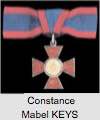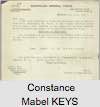| [Index] |
| Constance Mabel KEYS (1886 - 1964) |
| Children | Self + Spouses | Parents | Grandparents | Greatgrandparents |
| Constance Mabel KEYS (1886 - 1964) + Lionel Hugh KEMP-PENNEFATHER |
James KEYS (1843 - 1916) | Robert KEYS | ||
| Isabella MCFARLAND | ||||
| Margaret PELHAM (1854 - 1929) | ||||

|







|
| b. 30 Oct 1886 at Mt Perry, Queensland, Australia |
| +. Lionel Hugh KEMP-PENNEFATHER |
| d. 17 Mar 1964 at Southport, Queensland, Australia aged 77 |
| Parents: |
| James KEYS (1843 - 1916) |
| Margaret PELHAM (1854 - 1929) |
| Events in Constance Mabel KEYS (1886 - 1964)'s life | |||||
| Date | Age | Event | Place | Notes | Src |
| 30 Oct 1886 | Constance Mabel KEYS was born | Mt Perry, Queensland, Australia | 1886/C849 | ||
| 26 Jan 1916 | 29 | Death of father James KEYS (aged 73) | Brisbane, Queensland, Australia | 1916/B22755 | |
| 1929 | 43 | Death of mother Margaret PELHAM (aged 75) | Brisbane, Queensland, Australia | Note 1 | |
| 17 Mar 1964 | 77 | Constance Mabel KEYS died | Southport, Queensland, Australia | ||
| Note 1: 1929/B9602 born England aged 75 |
| Personal Notes: |
|
Keys, Constance Mabel (1886–1964)
by P. H. Merrillees and R. S. Merrillees This article was published in Australian Dictionary of Biography, Volume 9, (MUP), 1983 Constance Mabel Keys (1886-1964), nurse, was born on 30 October 1886 at Mount Perry, Queensland, seventh child of Irish-born James Keys, schoolteacher, and his wife Margaret, née Pelham, who was English. She trained at the Brisbane General Hospital and enlisted as a staff nurse in the Australian Army Nursing Service, Australian Imperial Force, on 21 September 1914; she embarked three days later. On arriving in Egypt Nurse Keys was posted to a British military hospital at Abbassia and then to the 1st Australian General Hospital at Heliopolis where she treated casualties from Gallipoli. She was promoted sister on 21 November 1915. On 4 December she joined the hospital ship Themistocles which was filled with wounded, and after arriving in Sydney re-embarked on 1 March 1916 for Egypt. There she briefly joined the 3rd A.G.H. at Abbassia, then went to England and on 5 October took up duty at the Kitchener Hospital, Brighton. She served in hospitals in England until 15 November 1917 when she was transferred to the 3rd A.G.H. at Abbeville, France. By this time she had been promoted head sister, A.A.N.S. On 9 February 1918 she went up the line as sister-in-charge of the 2nd Australian Casualty Clearing Station at Trois Arbres near Bailleul. For most of 1918 Constance Keys was seldom far from the front line. During the German offensive in March she and her staff were ordered to transfer the 2nd A.C.C.S. to Hazebrouck. On 12 April Hazebrouck was shelled and the station was transferred to St Omer which that night was heavily bombed. Five days later Sister Keys and her nurses rejoined their unit at Blendecques near St Omer and remained there until 4 September when the station was moved forward again to Hazebrouck. Conditions throughout this period were appalling. The retreat from Bailleul took place in cold, wet weather which made movement difficult and increased the suffering of the wounded and the escaping civilians. By the time Sister Keys had reached St Omer she and her staff had become, in her own words, 'refugees'. At Blendecques they had to treat many gassed patients, cope with an outbreak of influenza in June, and deal in July and August with casualties suffering from exhaustion as well as from wounds. After their advance to Hazebrouck in September the 2nd A.C.C.S. staff still had to nurse large numbers of sick and wounded. Two weeks later Sister Keys moved south with her staff to St Venant and then to Estaires, near Armentières, where many wounded civilians were admitted to the station. On 15 November the 2nd A.C.C.S. received cases at Tournai, Belgium, and after three weeks work there, opened again at Ath near Brussels. In January 1919 work slackened but in February influenza again broke out. Early in March the work of the station was handed over to the Royal Army Medical Corps Field Ambulance, and Sister Keys returned to England, where she spent some months with the 1st A.G.H. at Sutton Veny. She left England on 1 November and was discharged from the A.I.F. on 17 February 1920 in Melbourne. Sister Keys was one of the most highly decorated nurses in the A.A.N.S. She was twice mentioned in dispatches (1 December 1916 and 31 December 1918), received the Royal Red Cross, second class (29 December 1916) and first class (3 June 1919), and was awarded the Médaille des Epidémies in recognition of work for French refugees. After her return to Queensland Miss Keys became matron of a convalescent hospital for returned soldiers at Broadwater, Brisbane. While there she met and married on 3 December 1921 at Galloways Hill, Lionel Hugh Kemp-Pennefather, a Gallipoli veteran, who was in charge of the farm section at the hospital. Mrs Pennefather ceased her professional career after marrying but during World War II did voluntary work for service organizations. The Pennefathers lived in Brisbane until the 1950s when they moved to Southport. Survived by her husband, a son and a daughter, she died there on 17 March 1964 and was cremated with Anglican rites. Connie Keys was a gentle, compassionate and fearless woman whose courage is amply attested to by her decorations. She was also an accomplished pianist. Her citations, medals and other records are in the Medical Corps Museum at the Australian Army School of Health, Healesville, Victoria. |